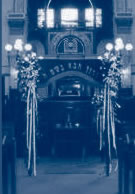|
SEDRA : TZAV Hertz Chumash p. 429 Leviticus
Chap. 6
This week's Sedra is generously sponsored by Stephen Pinch.
SYNOPSIS
The daily OLAH - burnt offering was considered an atonement
for the whole nation. Its culmination occurred when the ashes
of the Olah were removed by the Kohanim. The fire upon the
altar was never to go out - which was interpreted as a lesson
of perpetual enthusiasm for learning and living according
to the Torah. From the day of his induction, the High Priest
was to bring a meal-offering, morning and evening, at his
own expense on behalf of the priesthood. Additional laws regarding
the duties of the Kohanim and the sacrifices are provided.
In particular those portions of the offerings to which the
Kohanim were entitled and the conditions regulating their
consumption are specified.
Mention is made of the prohibition of consuming blood and
CHELEV - certain fats forbidden to be eaten as they were reserved
for burning on the altar.
A description of the installation of Aaron and his sons as
Kohanim ensues. In an impressive ceremony in the Court of
the Sanctuary, Moshe, watched by those assembled, conducts
the ceremony : the Kohanim bathe; Moshe robes Aaron in his
Priestly garments; he anoints the Tabernacle, its vessels
and instruments. The anointing oil is then poured on Aaron's
head, Sanctifying him. Then the regular Kohanim are consecrated
and invested with their garments. Moshe brings a sin-offering
and a burnt offering. This ritual continues for seven days
during which Aaron and his sons, the Kohanim, remain in the
Court of the Sanctuary.
IN SOME YEARS THIS SEDRA COINCIDES WITH SHABBAT PARAH
SPECIAL MAPHTIR - PARAH (The red heifer) HERTZ CHUMASH
P. 652 Numbers Chap. 19
This is the third of the four special Shabbatot leading up
to Pesach. It refers to the purification of those who had
come into contact with death. Such contact rendered a person
TAMEH (ritually `impure') and precluded their entry into the
Sanctuary or Temple. The purification ritual climaxed with
the sprinkling of water mixed with the ashes of a red heifer
over the candidate for purification.
Once TAHOR (ritually pure) again, entry to the Temple was
permissible. The "Pesach connection" - since the
entire nation was expected to partake of the Paschal Lamb,
which was a Temple ritual, it was necessary for all who had
become TAMEH to be purified before Pesach.
THE HAPHTORAH HERTZ CHUMASH P. 999 Ezechiel Ch. 36, verses
16 - 38
The theme of the haphtorah relates to the special maphtir
in that they both deal with the subject of purification. "How
Israel is to emerge from the grave of Exile, of undefiled
service of G-d".(Hertz)
TELL ME RABBI ...... THE STRUCTURE OF ALL OUR SERVICES
There is a simple logic and pattern to all our services,
Shacharit-Morning Service, Mincha-Afternoon Service (page
99, page 232) and Ma'ariv-Evening Service (page 116, 256).
Simply put, they all have a beginning, a middle and an end.
At the heart of each of these services is the Amidah (standing
prayer) also called Shemoneh Esreh (18 blessings) or simply
Tephillah ("Prayer").
Every time there is an Amidah it is "parallel" to
the corresponding daily sacrifice brought at that time when
the Temple was still in existence.
Shacharit arises out of the daily communal burnt offering
brought in the morning of each day.
Mincha means the Gift Offering brought in the afternoon, hence
its identification as the Afternoon Service.
Maariv corresponds with the burning of the limbs, fats and
the remainder of the daily offerings and does not have as
specific a focus on a particular sacrifice as does Shacharit,
Mincha and Mussaph.
Mussaph (Additional) is also an Amidah prayer and is added
whenever there was an Additional sacrifice such as for Shabbat,
Festivals and Rosh Chodesh.
The most elaborate and developed of our daily services is
Shacharit
THE BEGINNING
The introductory sections of the three daily prayers vary
in their extent, volume and complexity. Shacharit begins with
Birchot Hashachar, Early Morning Blessings (page 11, 12),
which commence with prayers referring to arising in the morning,
our ablutions, the Blessing for Studying Torah, a series of
Blessings referring to the gifts of life, our identity and
the world G-d has created. Having recited a blessing for Torah
study this section incorporates a threefold level of such
learning with extracts from the written law, Torah, and from
the Oral law in the form of Mishna and Talmud.
The next section is Pesuke D'Zimra, Verses of Song (page17,
58) comprised of Psalms, hymns and Biblical extracts of praise
of G-d to engender the appropriate spirit of devotion for
serious prayer. This Section is introduced by a Blessing Called
"Baruch She'amar" (page 17) in which we express
our intention to praise G-d. It concludes with a blessing
called Yishtabach (page 175, 82), which is almost mirror image
of Baruch She'amar. In this blessing we confirm that we have
set out to praise G-d. The Verses of Song for Shabbat contain
additional Psalms and praises.
The introduction for Mincha consists only of Psalm 145, Ashre
(page 99, 66).
Maariv too has a very brief introduction, the short statement
of "V'hoo rachum" (page 116, 256).
THE MIDDLE
The heart of our Prayers as mentioned above is the Amidah
(page 46, 98). It too is structured with a beginning of introductory
blessings. These are followed by the central blessings in
which we express our commitment to various principles and
ideals of Jewish life, petition G-d for our needs and also
express out thanks to Him for his abundant blessings and the
benefits He bestows upon us, concluding with a prayer for
peace. The Amidah for Shabbat and Festivals (page 186, 420)
has the same introductory and concluding blessings as on weekdays,
but there are no petitions, only references to the significance
of the day. The Mussaph (page 210, 462) too incorporates the
beginning and end blessings as on weekdays, while the central
portion describes the sacrifices in honour of the Festival
or occasion being celebrated. The Morning, Mussaph and afternoon
Services have the Amidah repeated by the Chazan and also include
Kedusha, statements Sanctifying G-d.
In addition to the Amidah, the Morning and Evening prayers
are so structured as to incorporate the fulfilment of our
obligation as expressed in the Torah to recite the Shma (page
41, 90) morning and evening. The Shma is always preceded and
followed by blessings, two blessings morning and evening before
the Shma, and one blessing in the morning and two blessings
in the evening following the Shma.
After the Amidah the Torah is read on Shabbat, Festivals,
Rosh Chodesh, Mondays and Thursdays.
At Shabbat Mincha, the Torah is read before the Amidah.
THE END
Following the Amidah are some concluding prayers. Alenu (page
221, 480) has been common to all services for about a thousand
years and originates from the Mussaph of our Rosh Hashannah
Prayers. The end of the morning service includes The Psalm
of the day which dates back to Temple times and various other
prayers such as En Kelohenoo.
The singing of the hymns Adon Olam and Yigdal are of more
recent vintage dating from the middle Ages and probably reflect
an intention not to depart the Synagogue immediately, but
tarry in the Holy place for a little longer.
KADDISH
The various sections of our prayers are punctuated or delineated
by the recitation of Kaddish, a prayer of Sanctification.
To separate between the sections there is usually a "Half
Kaddish" such as the one between the Verses of Song and
the blessings preceding the Shma, before and after Reading
the Torah.
A full Kaddish contains the petition "Titkabel"
(page 221, 480) - may our prayers be received - is related
to and always follows the Amidah which is "Prayer"
par excellence.
At the conclusion of a Section of Study Rabbis Kaddish (page
15, 52), is recited.
BACK TO SHABBAT SHALOM
TABLE
|








